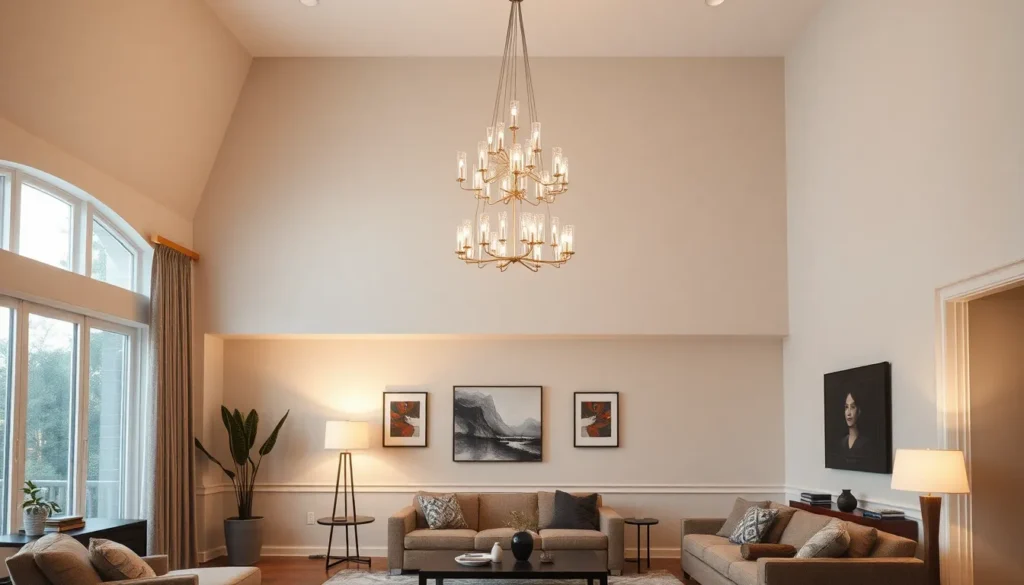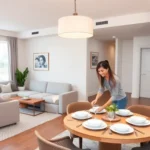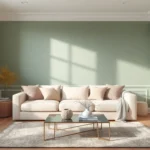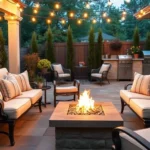The right ceiling lights can transform your living room from ordinary to extraordinary. We’ve all experienced that moment when we walk into a beautifully lit space and feel instantly drawn to its warmth and ambiance. Your living room deserves that same magnetic appeal.
Choosing the perfect ceiling lighting isn’t just about brightness – it’s about creating layers of illumination that enhance your space’s functionality and aesthetic appeal. Whether you’re hosting dinner parties or enjoying quiet evenings at home, the right lighting sets the mood for every occasion.
We’ve curated a collection of stunning ceiling light ideas that’ll elevate your living room’s design while meeting your practical needs. From statement chandeliers that command attention to sleek recessed lights that provide subtle sophistication, these options will help you create the perfect lighting scheme for your space.
Consider Your Living Room Size and Layout When Choosing Ceiling Lights
Selecting the perfect ceiling lights requires understanding how your living room’s dimensions and configuration influence both illumination effectiveness and visual appeal. We’ll guide you through the essential measurements and spatial considerations that ensure your lighting choices complement your space beautifully.
Measure Your Space for Proper Light Fixture Scaling
Square footage determines fixture size for optimal proportions in your living room ceiling lights. We recommend calculating your room’s length and width in feet, then adding those numbers together to determine your chandelier’s ideal diameter in inches. For example, a 12-foot by 16-foot room works best with a 28-inch diameter fixture.
Multiple smaller fixtures often work better than one oversized piece in larger living spaces exceeding 400 square feet. We suggest using two medium chandeliers or a combination of pendant lights and recessed lighting to distribute illumination evenly across expansive areas.
Compact rooms under 150 square feet benefit from flush mount ceiling lights or semi-flush fixtures that don’t overwhelm the space. We find that fixtures measuring 12 to 18 inches in diameter provide adequate lighting without creating visual clutter in smaller living rooms.
Account for Furniture Placement and Traffic Flow
Seating arrangements should guide your ceiling light positioning to avoid shadows and glare on conversation areas. We position chandeliers or pendant lights to illuminate the center of seating groups, typically 30 to 36 inches above coffee tables or ottomans.
Walking paths require consistent overhead lighting to ensure safe navigation through your living room. We recommend installing recessed lights along main traffic routes, spacing them 4 to 6 feet apart for even coverage without creating dark spots.
Entertainment zones need specialized lighting consideration when housing televisions or reading nooks. We suggest using dimmable ceiling lights in these areas, allowing you to adjust brightness levels based on activities while preventing screen glare during movie nights.
Evaluate Ceiling Height for Appropriate Fixture Selection
Standard 8-foot ceilings work best with flush mount or semi-flush mount fixtures that maintain at least 7 feet of clearance for comfortable movement. We choose fixtures extending no more than 12 inches below the ceiling plane in these spaces.
Vaulted or high ceilings above 10 feet accommodate dramatic chandeliers and statement pendant lights that create visual interest. We hang these fixtures 7 to 8 feet above the floor, allowing their grand proportions to fill the vertical space effectively.
Sloped ceilings require special mounting hardware and fixture selection to ensure proper installation and appearance. We recommend adjustable fixtures or those specifically designed for angled mounting, maintaining visual balance even though the ceiling’s irregular plane.
Explore Chandelier Options for Statement Ceiling Lighting
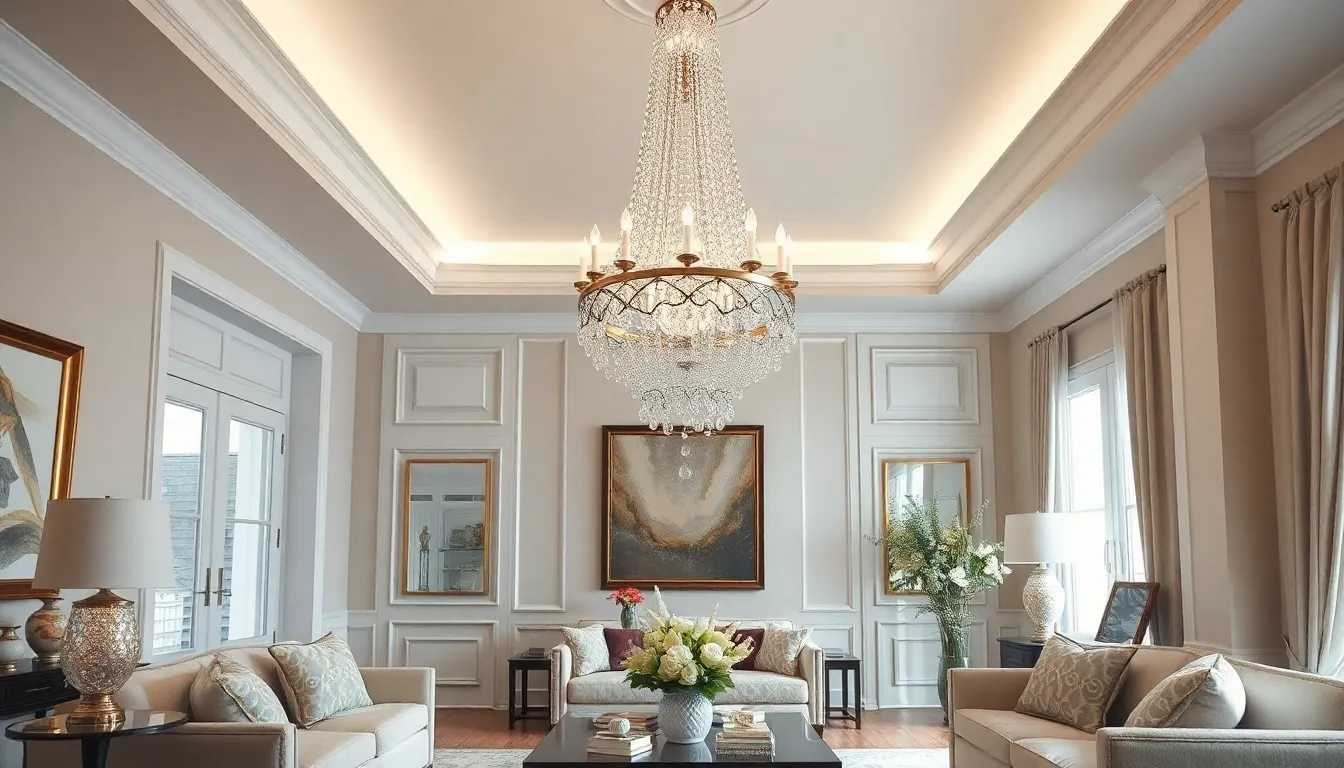
Chandeliers create dramatic focal points that transform ordinary living rooms into sophisticated spaces. We’ve curated three distinct chandelier styles that offer versatile answers for different design aesthetics.
Traditional Crystal Chandeliers for Elegant Living Rooms
Traditional crystal chandeliers bring timeless sophistication to living rooms with their intricate crystal details and classic design elements. These fixtures work exceptionally well in formal living spaces where elegance takes priority over contemporary minimalism.
Crystal elements refract light beautifully throughout the room, creating stunning visual effects that enhance the overall ambiance. We recommend positioning these chandeliers in spaces with higher ceilings to showcase their full grandeur and prevent overwhelming smaller rooms.
Modern Geometric Chandeliers for Contemporary Spaces
Modern geometric chandeliers feature clean lines and structured shapes that complement contemporary living room designs perfectly. These fixtures often incorporate LED technology, providing energy efficient lighting while maintaining a sleek appearance.
Geometric patterns create visual interest without cluttering the space, making them ideal for minimalist interiors. We find these chandeliers work particularly well in open concept living areas where they can serve as sculptural elements that define the seating zone.
Rustic and Industrial Chandelier Designs
Rustic and industrial chandelier designs use materials like metal and reclaimed wood to create distinctive statement pieces. These fixtures add character to living rooms by introducing natural textures and weathered finishes that complement farmhouse or loft style interiors.
Metal framework combined with wood accents creates a balanced look that feels both sturdy and warm. We suggest these designs for living rooms with exposed beams or brick walls where the industrial aesthetic can be fully appreciated.
Install Recessed Lighting for Clean and Versatile Illumination

Recessed lighting transforms living rooms with its minimalist approach that delivers focused illumination without overwhelming your space. We recommend this solution for rooms with low ceilings where traditional fixtures might feel cramped or intrusive.
Strategic Placement of Recessed Lights for Even Coverage
Strategic positioning creates balanced illumination throughout your living room by distributing light sources systematically across the ceiling. We suggest placing recessed lights in symmetrical patterns that complement your room’s layout and furniture arrangement.
Spacing calculations ensure optimal coverage by measuring the distance between fixtures at approximately half the ceiling height. If your ceiling measures 8 feet high, position each light about 4 feet apart for seamless brightness distribution. Target exact areas like reading nooks, artwork displays, or conversation zones with dedicated fixtures to highlight these functional spaces.
Consider traffic patterns when determining light placement to ensure safe navigation throughout your living room. We position lights along pathways and near entryways to eliminate dark corners and potential hazards. Multiple zones benefit from independent switching controls that allow you to illuminate only the areas you’re using.
Dimmer Controls for Adjustable Ambient Lighting
Dimmer switches enhance the versatility of recessed lighting by offering complete control over your living room’s atmosphere. We install these controls to transition seamlessly from bright task lighting during active hours to soft ambient glow for relaxation.
Variable brightness levels accommodate different activities throughout your day, from reading and working to watching movies or entertaining guests. Professional installation ensures compatibility between your dimmer switches and LED bulbs to prevent flickering or buzzing issues. Smart dimmer options connect to home automation systems, allowing you to adjust lighting remotely or create preset scenes for various occasions.
LED Recessed Options for Energy Efficiency
LED recessed lights deliver exceptional energy savings while providing superior illumination quality for modern living rooms. We choose LED options because they consume up to 80% less energy than traditional incandescent bulbs and last significantly longer.
Color temperature selection allows you to customize the ambiance, with warm white (2700K-3000K) creating cozy atmospheres and cool white (4000K-5000K) providing crisp, modern illumination. Heat generation remains minimal with LED technology, reducing strain on your cooling system and maintaining comfortable room temperatures.
Installation flexibility accommodates various ceiling types and insulation requirements, with IC-rated housings allowing direct contact with insulation materials. We recommend choosing fixtures with high CRI (Color Rendering Index) ratings above 90 to ensure accurate color representation of your furniture and decor.
Add Pendant Lights for Focused Task and Accent Lighting
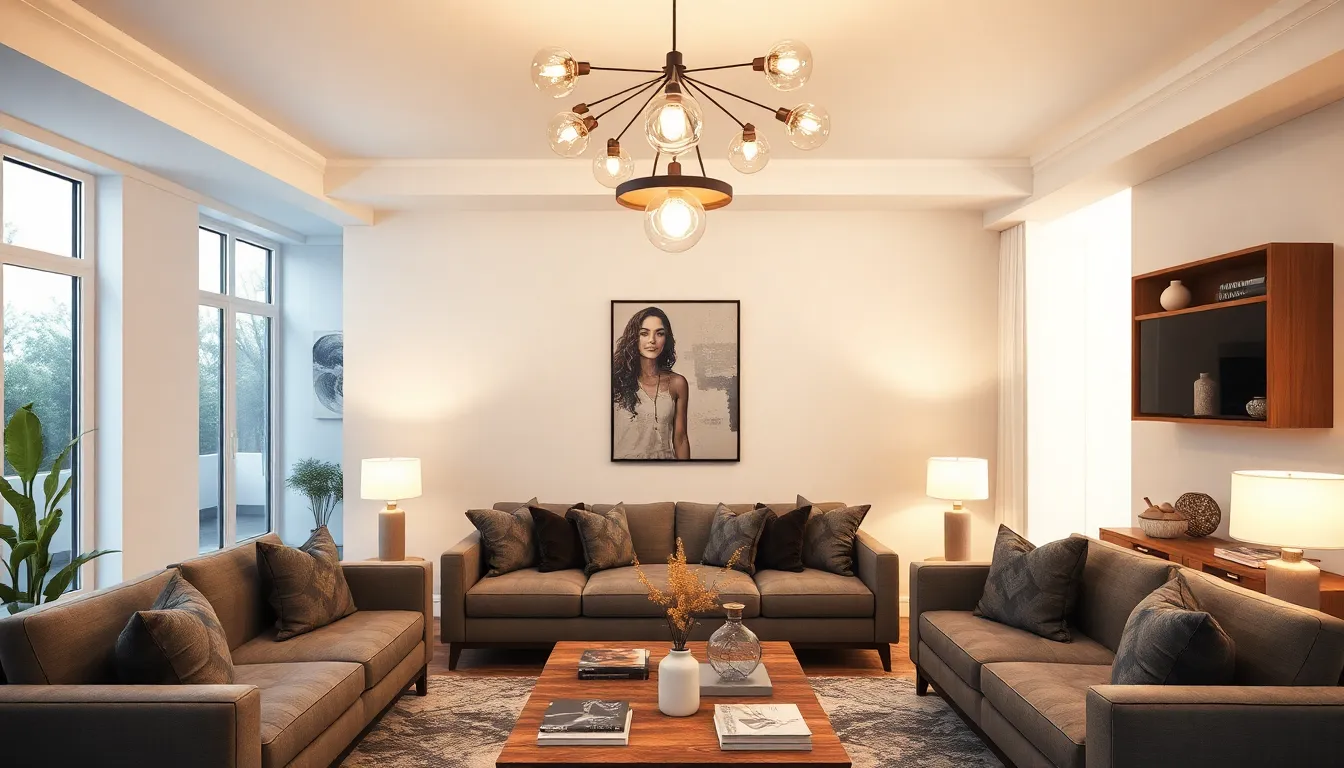
Pendant lights excel at delivering targeted illumination exactly where you need it most in your living room. These versatile fixtures enhance both task lighting and accent lighting by drawing attention to exact zones while providing functional brightness for activities like reading or conversation.
Cluster Pendant Arrangements Over Seating Areas
Cluster pendant arrangements create stunning visual impact when we position multiple pendants together above seating areas. Modern living rooms increasingly feature these grouped fixtures to define conversation zones and improve ambient lighting distribution throughout the space.
Strategic placement over sectional sofas or coffee tables transforms ordinary seating into well-lit focal points. We recommend spacing pendants 18-24 inches apart within clusters to achieve balanced illumination without overcrowding the visual field.
Zone definition becomes effortless when cluster arrangements anchor exact furniture groupings. These installations serve dual purposes as both artistic elements and practical lighting answers that enhance the room’s overall design coherence.
Single Statement Pendants as Focal Points
Statement pendants command attention as dramatic centerpieces that anchor your living room’s entire aesthetic. Large or uniquely designed fixtures positioned above coffee tables or at room center create instant conversation starters while providing essential ambient lighting.
Design variety spans from organic forms inspired by nature to polished metal finishes that deliver glamorous effects. We’ve seen homeowners choose oversized drum pendants, sculptural glass designs, and geometric metal fixtures to complement their exact decor styles.
Positioning strategy matters significantly for maximum visual impact and functional lighting coverage. Single statement pendants work best when hung 30-36 inches above coffee tables or 7-8 feet from the floor in open areas to maintain proper proportions.
Adjustable Height Pendants for Flexibility
Adjustable height pendants adapt seamlessly to changing room layouts and evolving lighting needs throughout different times of day. This practical feature proves invaluable for multi-purpose living spaces that serve various functions from entertaining to relaxation.
Versatile positioning allows us to raise fixtures during parties for unobstructed sight lines or lower them for intimate task lighting during reading sessions. Many adjustable models feature pulley systems or telescoping mechanisms that make height changes simple and secure.
Style compatibility remains consistent across various design preferences, with adjustable pendants available in contemporary metals, traditional fabrics, and rustic materials. We recommend choosing fixtures with clean adjustment mechanisms that complement rather than detract from the overall aesthetic.
Incorporate Track Lighting Systems for Directional Control

Track lighting systems give you unprecedented control over how light moves through your living room space. These versatile fixtures let you direct illumination exactly where you need it most.
Adjustable Track Heads for Art and Feature Highlighting
Adjustable track heads provide precise directional control that’s perfect for showcasing artwork and architectural details in your living room. Moving these fixtures along the track allows you to focus light on different areas depending on your current needs and room arrangements.
Positioning flexibility makes track heads ideal for highlighting exact features like gallery walls, built-in shelving, or decorative elements that deserve attention. Rotating the heads 360 degrees gives you complete control over light direction without rewiring or repositioning the entire fixture.
Multiple beam angles enhance your lighting options since track heads come with various lenses and bulb types to create focused spotlights or wider flood patterns. Combining different beam angles on the same track creates layered lighting effects that add depth and visual interest to your space.
Linear Track Systems for Modern Living Room Aesthetics
Linear track configurations deliver sleek modern appeal that spans across your ceiling in clean, uninterrupted lines. These contemporary systems maintain minimalist aesthetics while providing functional lighting throughout your living area.
Streamlined designs complement modern decor by eliminating visual clutter and creating sophisticated ceiling treatments that enhance rather than compete with your furniture and accessories. Linear tracks work especially well in open concept spaces where clean lines reinforce the room’s architectural flow.
Installation versatility accommodates various ceiling types since linear systems can mount to standard flat ceilings or adapt to slightly angled surfaces. Their low profile design makes them suitable for rooms with standard ceiling heights without overwhelming the space.
Curved Track Options for Unique Ceiling Configurations
Curved track systems adapt to irregular ceiling shapes like vaulted, slanted, or coffered designs that standard fixtures can’t accommodate effectively. These flexible systems follow your ceiling’s contours while maintaining consistent lighting coverage.
Custom configurations create unique visual elements that turn your lighting into an architectural feature rather than just a functional necessity. Curved tracks can follow the lines of tray ceilings or create sweeping arcs that add movement and drama to your room design.
Flexibility advantages extend beyond unusual ceilings since curved systems can wrap around columns, follow curved walls, or create interesting geometric patterns that serve as decorative elements. This adaptability makes them perfect for living rooms with challenging layouts or distinctive architectural features.
Choose Flush Mount Fixtures for Low Ceiling Solutions
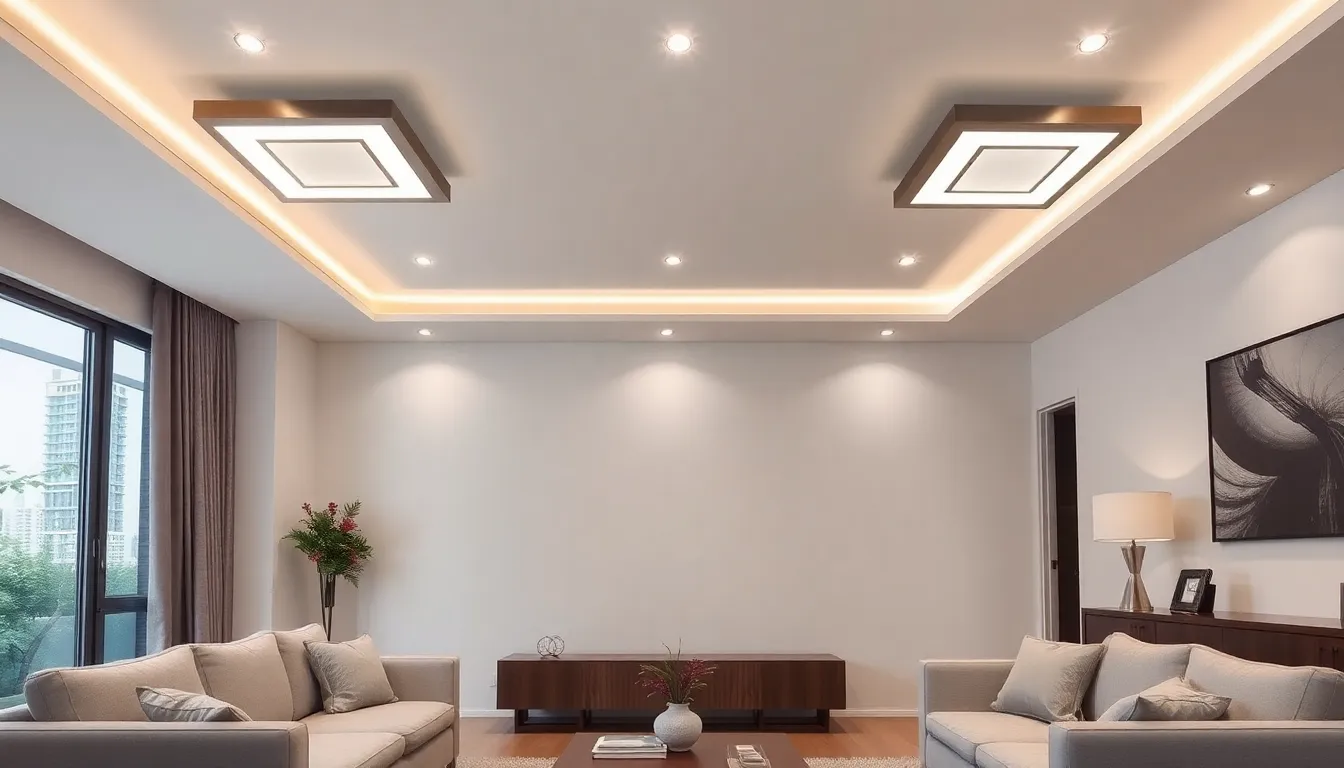
When dealing with low ceilings in your living room, flush mount fixtures provide an elegant solution that maximizes vertical space while delivering effective illumination. We recommend these ceiling hugging designs for modern homes where every inch of headroom matters.
Contemporary Flush Mount Designs for Style and Function
Contemporary flush mount fixtures feature clean lines and minimalist shapes that perfectly complement modern living room aesthetics. We love how these designs emphasize simplicity while maintaining sophisticated style through neutral tones and streamlined silhouettes. Modern flush mounts install directly against the ceiling surface, creating an unobtrusive lighting solution that won’t overwhelm your space.
Geometric shapes dominate contemporary flush mount design trends, offering everything from circular profiles to angular rectangular forms. We find that square and rectangular fixtures work particularly well in rooms with modern furniture and architectural elements. Neutral color palettes including white, black, and metallic finishes ensure these fixtures blend seamlessly with existing decor while providing the functionality you need.
LED Flush Mount Options for Bright, Even Light Distribution
LED flush mount fixtures deliver superior energy efficiency compared to traditional lighting options while providing consistent illumination throughout your living room. We appreciate how integrated LED panels eliminate harsh shadows and reduce glare, creating a soft ambient glow that’s perfect for both relaxation and entertaining guests.
Built in LED arrays distribute light evenly across the ceiling surface, preventing the hot spots and dark areas common with traditional bulb fixtures. We recommend LED flush mounts for their impressive longevity and reduced maintenance requirements, as these systems typically last years longer than conventional lighting answers. Energy savings become particularly noticeable in living rooms where lights operate for extended periods during evening hours.
Decorative Flush Mounts That Add Visual Interest
Decorative flush mount fixtures transform your ceiling into a design focal point without sacrificing the low profile installation you need. We suggest textured glass options that create beautiful light patterns on your walls and ceiling, adding depth and visual complexity to your living space. Metal detailing and unique geometric shapes allow you to personalize your room while maintaining that essential ceiling clearance.
Finish options include brushed nickel, matte black, and antique brass, giving you flexibility to match various decor styles from industrial to traditional. We find that decorative flush mounts work especially well as statement pieces in smaller living rooms where a single fixture can provide both adequate lighting and serve as an artistic element. Multiple decorative flush mounts can create layered lighting effects in larger spaces when combined with floor lamps or wall sconces.
Layer Different Ceiling Light Types for Complete Illumination
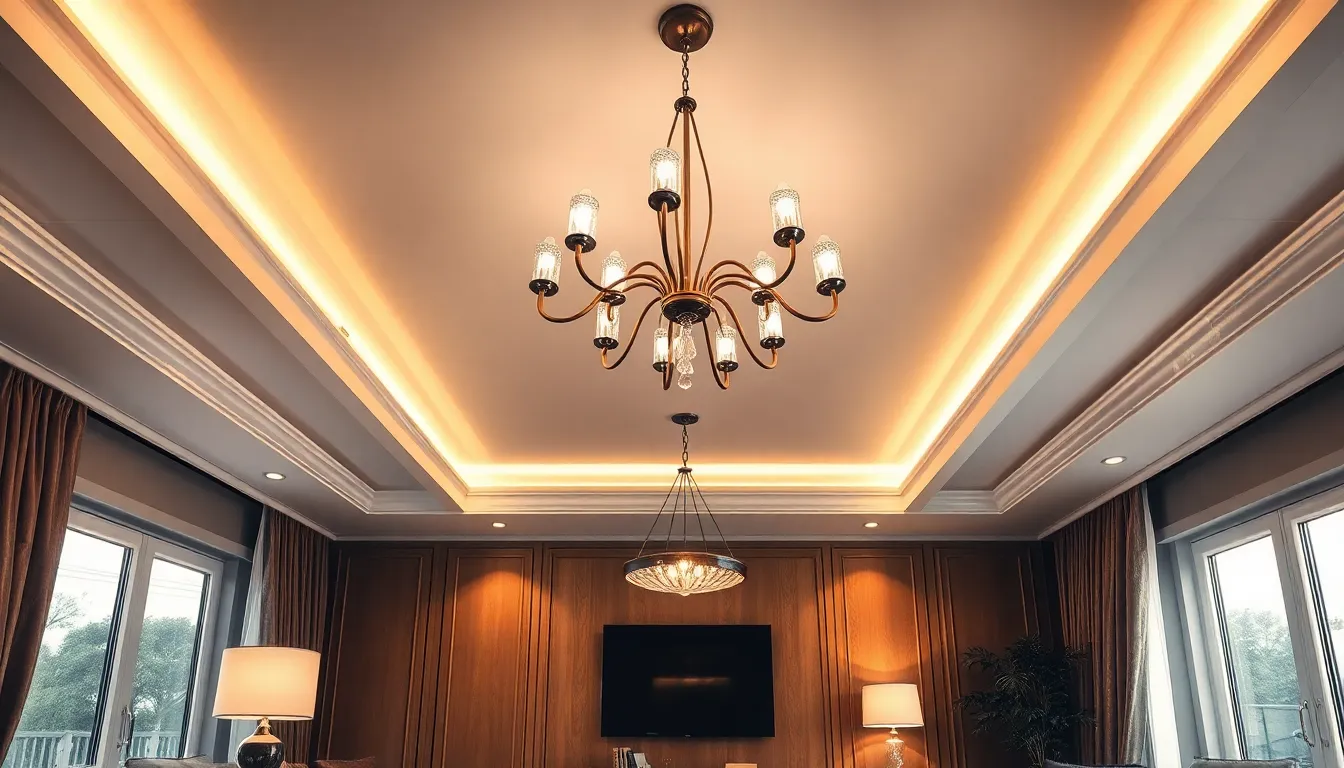
Combining multiple ceiling light fixtures creates depth and functionality throughout your living space. We’ll explore how mixing different lighting types transforms your room into a well-illuminated haven that adapts to every occasion.
Combine Ambient, Task, and Accent Lighting Sources
Ambient lighting serves as your room’s foundation by providing general illumination that fills the entire space. Chandeliers and flush mount fixtures excel at delivering this essential base layer, creating a comfortable brightness level for daily activities. We recommend positioning these primary sources centrally to ensure even coverage across your living room.
Task lighting delivers focused illumination for exact activities like reading or working on hobbies. Recessed lights work perfectly for this purpose, offering targeted brightness without visual clutter in rooms with lower ceiling heights. Pendant lights also provide excellent task lighting when positioned over reading nooks or side tables where concentrated light enhances functionality.
Accent lighting highlights architectural features, artwork, or decorative elements to add visual interest and depth. Spotlights integrated into recessed housing create dramatic effects on wall art or built-in shelving. Semi-flush mount fixtures can serve dual purposes by providing both ambient and accent lighting when equipped with directional capabilities.
Create Lighting Zones for Different Living Room Activities
Reading areas require dedicated pendant lights or adjustable fixtures that deliver focused illumination without creating glare on book pages. Position these lights slightly forward of seating to prevent shadows from falling across reading materials. We suggest installing dimmer controls to adjust brightness levels based on reading preferences and time of day.
Television zones benefit from recessed lights positioned behind or to the sides of viewing areas to reduce screen glare while maintaining ambient visibility. Keep these fixtures on low settings during movie nights to prevent eye strain. Multiple recessed lights distributed across this zone create balanced lighting that doesn’t compete with screen brightness.
Social gathering spaces shine with chandeliers or statement pendant lights that create welcoming atmospheres for entertaining guests. These fixtures serve as conversation pieces while providing adequate illumination for face-to-face interaction. Halo chandeliers particularly excel in larger spaces where they can illuminate expansive seating arrangements effectively.
Use Smart Controls to Manage Multiple Light Sources
Smart lighting systems allow you to control brightness levels, color temperature, and scheduling from your smartphone or voice assistant. These systems coordinate multiple ceiling fixtures simultaneously, creating seamless transitions between different lighting scenarios throughout your day. We can program preset scenes that automatically adjust various light sources for exact activities.
Remote management capabilities enable you to turn lights on before arriving home or adjust settings without leaving your seat. Smart controls integrate with home automation systems to create lighting schedules that adapt to your daily routines. Energy monitoring features help track usage patterns and optimize efficiency across all connected fixtures.
Zone control functionality lets you operate different lighting areas independently through smart switches and dimmers. Group recessed lights separately from chandeliers to fine-tune illumination levels for exact zones. Color temperature adjustments transform your living room from bright daylight tones for productivity to warm evening hues for relaxation.
Select Energy-Efficient LED Ceiling Light Options
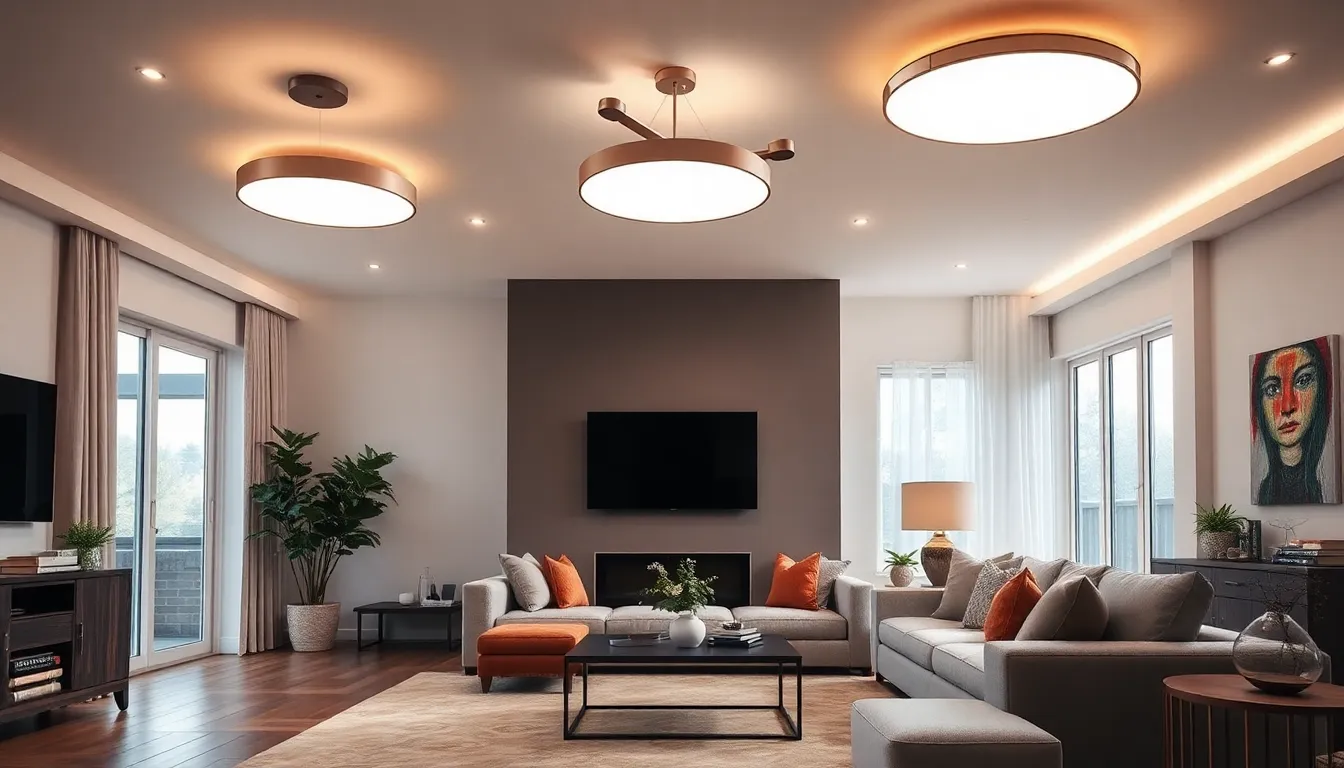
LED ceiling lights offer superior performance and efficiency compared to traditional lighting answers. These fixtures provide exceptional value through reduced energy consumption and extended lifespan benefits.
Long-Term Cost Savings with LED Technology
LED lights consume significantly less power than traditional bulbs, leading to reduced energy costs over time. Our analysis shows that LED fixtures can cut electricity bills by up to 75% compared to incandescent alternatives. The longevity of LED technology minimizes the need for frequent replacements, with most LED ceiling lights lasting 25,000 to 50,000 hours.
We recommend calculating your potential savings by comparing wattage consumption between LED and traditional options. A typical living room with four 60-watt incandescent bulbs costs approximately $175 annually to operate, while equivalent LED fixtures cost only $44 per year. The initial investment in LED ceiling lights typically pays for itself within 2-3 years through energy savings alone.
| Light Type | Wattage | Annual Cost* | Lifespan (Hours) |
|---|---|---|---|
| LED | 10W | $11 | 25,000-50,000 |
| Incandescent | 60W | $44 | 1,000 |
| CFL | 14W | $15 | 8,000 |
*Based on $0.12/kWh, 8 hours daily use
Color Temperature Choices for Different Moods
Color temperature dramatically affects the atmosphere and functionality of your living room lighting. Warm white options ranging from 2700K to 3000K create a cozy and relaxing atmosphere, making them ideal for evening gatherings and intimate conversations. Cool white temperatures between 3500K and 4100K provide bright and energizing light that’s suitable for tasks or daytime activities.
Daylight options from 5000K to 6500K offer vibrant and alerting illumination, perfect for reading areas or workspaces within your living room. We suggest selecting fixtures that match your room’s primary function and time of use. Living rooms used primarily for relaxation benefit from warmer temperatures, while multipurpose spaces require adjustable options.
Many LED ceiling lights now offer tunable white technology, allowing you to adjust color temperature throughout the day. This feature helps maintain your natural circadian rhythm while providing optimal lighting for various activities.
Smart LED Systems for Convenience and Control
Smart lighting systems allow users to control light intensity and color temperature remotely, improving your room’s ambiance and functionality through smartphone apps or voice commands. These systems integrate seamlessly with popular home automation platforms like Amazon Alexa, Google Home, and Apple HomeKit.
Dimming and scheduling features enable you to adjust lighting based on time of day or desired mood, optimizing energy efficiency automatically. We find that programmable schedules can reduce energy consumption by an additional 20-30% beyond standard LED savings. Smart LED ceiling lights can gradually brighten in the morning to simulate sunrise or dim in the evening to prepare for bedtime.
Advanced smart systems offer scene presets for different activities like movie watching, entertaining guests, or reading. These presets combine multiple light sources at predetermined brightness levels and color temperatures, creating the perfect atmosphere with a single command. Motion sensors and occupancy detection further enhance convenience by automatically adjusting lighting when you enter or leave the room.
Match Ceiling Light Styles to Your Living Room Decor
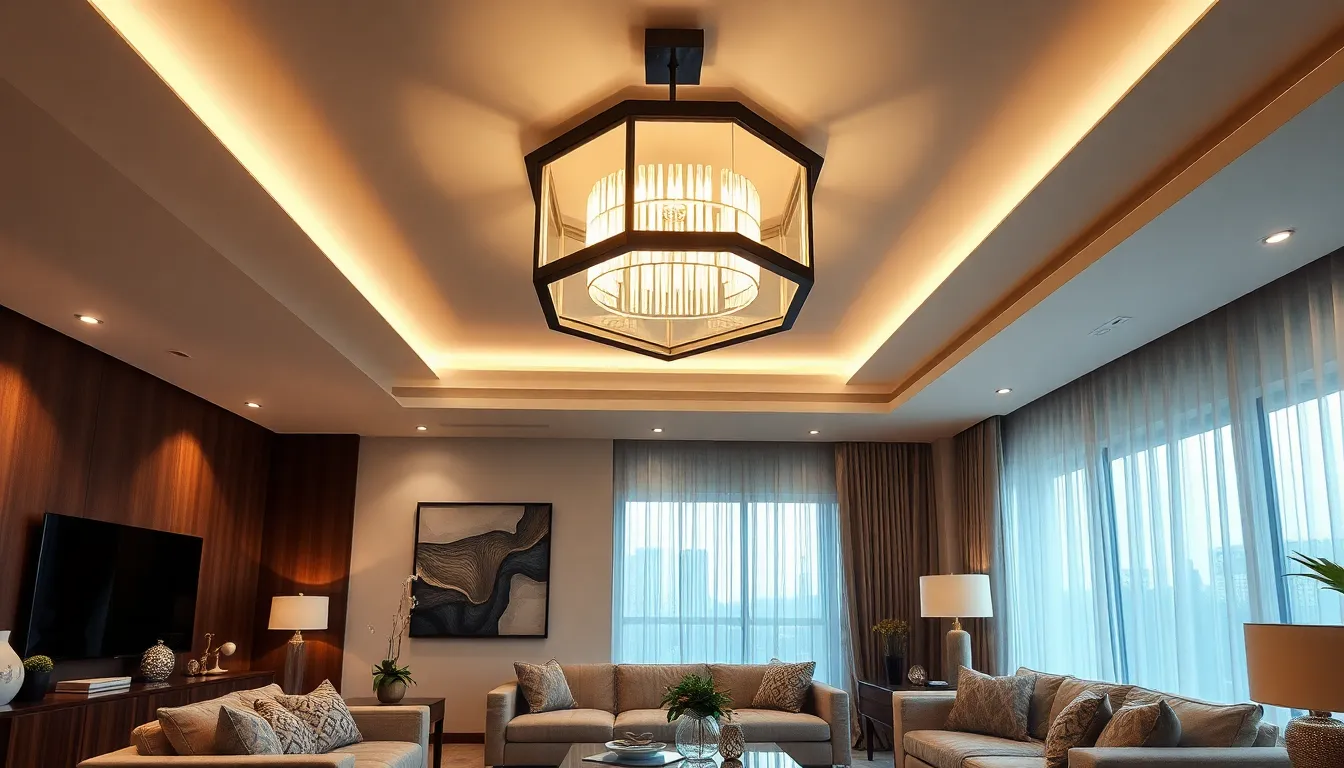
Selecting ceiling lights that harmonize with your existing decor creates a cohesive and polished living room design. We’ll explore how to coordinate finishes, complement design themes, and maintain proper proportions for optimal visual impact.
Coordinate Finishes with Existing Hardware and Fixtures
Metal finishes play a crucial role in creating visual cohesion throughout your living space. Gold, brass, polished chrome, and matte black are the most popular options that should complement your door handles, cabinet hardware, and other fixtures. We recommend matching at least two metal finishes in the same room to establish a consistent design language.
Material combinations offer additional opportunities for coordination beyond metals alone. Glass, fabric, and metal surfaces can enhance visual interest when they echo other elements in your room. Shiny surfaces reflect light and make spaces feel larger, while textured materials add depth and character to your ceiling lighting choices.
Hardware consistency extends to switch plates, outlet covers, and curtain rods throughout the living room. We’ve found that maintaining the same finish family creates a more expensive and intentional look, even when using budget friendly fixtures.
Choose Designs That Complement Your Interior Design Theme
Modern decor pairs beautifully with geometric shaped flush mount or integrated LED ceiling lights that provide sleek, contemporary appeal. Clean lines and minimalist forms work best in these spaces, avoiding ornate details that might clash with the streamlined aesthetic.
Traditional decor benefits from chandeliers and classic lantern style fixtures that add elegance and timeless charm to your living room. These fixtures often feature intricate details, curved arms, and classic proportions that complement formal furniture arrangements.
Industrial themes work exceptionally well with pendant lights featuring exposed bulbs, metal frames, or mixed materials. Raw finishes like weathered steel or aged brass enhance the authentic industrial character while providing functional illumination.
Farmhouse styles embrace lantern style fixtures with exposed bulbs or fabric shades that offer rustic appeal. Natural materials like wood, rope, or galvanized metal reinforce the casual, countryside atmosphere.
Nature inspired decor incorporates organic shaped pendants made from rattan, glass, or ceramic materials. Forms inspired by eggshells, mushrooms, or other natural elements are currently trending and bring warmth to contemporary living spaces.
Minimalist interiors require simple, streamlined flush mount or recessed lights that maintain clean lines without visual clutter. We suggest avoiding fixtures with multiple elements or decorative details that might overwhelm the space.
Consider Scale and Proportion with Room Elements
Room size directly impacts your ceiling light selection, with large rooms accommodating grand chandeliers or multiple pendant lights effectively. Smaller rooms benefit from flush mounts or compact semi flush fixtures that provide adequate illumination without overwhelming the space.
Ceiling height determines appropriate fixture types and hanging lengths for optimal visual balance. High ceilings suit long pendant drops or tiered chandeliers that fill vertical space, while low ceilings require low profile or flush mount lights to prevent crowding.
Fixture sizing should remain proportional to your furniture and architectural elements for proper balance. We calculate ideal chandelier diameter by adding your room’s length and width in feet, with the sum equaling the recommended diameter in inches.
| Room Dimension | Recommended Fixture Size | Fixture Type |
|---|---|---|
| 10′ x 12′ | 22″ diameter | Medium chandelier or pendant |
| 12′ x 15′ | 27″ diameter | Large chandelier |
| 8′ x 10′ | 18″ diameter | Small chandelier or flush mount |
| 15′ x 20′ | Multiple fixtures | Chandelier + recessed combo |
Furniture scale influences how your ceiling lights appear in relation to seating arrangements and coffee tables. Large sectional sofas can handle more substantial fixtures, while compact furniture groupings work better with proportionally smaller lighting elements.
Conclusion
Transforming your living room through thoughtful ceiling light selection doesn’t have to be overwhelming. We’ve explored how the right combination of ambient task and accent lighting can create the perfect atmosphere for any occasion while improving your home’s overall design aesthetic.
Remember that successful lighting design balances functionality with style. Whether you choose statement chandeliers energy-efficient LED recessed lights or smart lighting systems the key lies in understanding your space’s unique requirements and your lifestyle needs.
By considering factors like room dimensions ceiling height and existing decor you’ll create a cohesive lighting scheme that serves both practical and decorative purposes. The investment in quality ceiling lights pays dividends through improved ambiance reduced energy costs and enhanced daily living experiences in your most-used space.
Frequently Asked Questions
What size chandelier should I choose for my living room?
The ideal chandelier diameter in inches should equal the combined length and width of your room in feet. For example, a 12×16 foot room would need a 28-inch diameter chandelier. For larger spaces, consider multiple smaller fixtures for even illumination, while compact rooms benefit from flush mount or semi-flush fixtures.
How do I layer different types of ceiling lights effectively?
Combine ambient, task, and accent lighting for complete illumination. Use chandeliers or flush mounts for general brightness, recessed or pendant lights for focused activities, and accent lighting to highlight architectural features. Smart controls help manage multiple light sources and adjust brightness for different scenarios.
What’s the difference between LED and traditional ceiling lights?
LED ceiling lights consume significantly less power than incandescent or CFL bulbs, resulting in lower energy costs and longer lifespans. They offer customizable color temperatures and superior performance. While initial costs may be higher, LEDs provide substantial long-term savings and enhanced convenience through smart features.
How should I position recessed lights in my living room?
Space recessed lights symmetrically with strategic placement for even coverage. Calculate spacing based on ceiling height and room dimensions. Focus on illuminating seating areas and ensuring safe navigation through traffic zones. Use dimmer controls for adjustable ambient lighting from bright task lighting to soft ambient glow.
How do I match ceiling lights to my existing decor?
Coordinate finishes with existing hardware and fixtures, matching at least two metal finishes for visual consistency. Consider your interior theme – modern spaces suit geometric designs, traditional rooms work with crystal chandeliers, and industrial styles complement metal fixtures. Ensure proper scale and proportion based on room size and furniture.
What ceiling light types work best for low ceilings?
For rooms with low ceilings, choose flush mount or semi-flush fixtures that sit close to the ceiling. Recessed lighting is particularly effective as it provides clean, versatile illumination without taking up visual space. Avoid hanging chandeliers or pendant lights that could make the room feel cramped.
Can I control multiple ceiling lights with smart technology?
Yes, smart lighting systems allow remote management of multiple light sources through apps or voice commands. You can adjust brightness, color temperature, and create programmable schedules or scene presets for various activities. Smart controls also enable energy monitoring and enhance convenience in lighting design.
